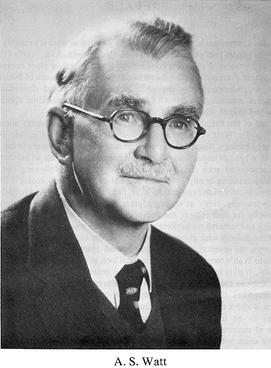Alexander Watt facts for kids
Quick facts for kids
Alexander Stuart Watt
|
|
|---|---|
 |
|
| Born | 21 June 1892 Aberdeenshire, Scotland
|
| Died | 2 March 1985 (aged 92) Cambridge, England
|
| Alma mater | University of Aberdeen |
| Known for | cyclic succession in ecology |
| Awards | Linnean Medal (1975) Fellow of the Royal Society |
| Scientific career | |
| Fields | Ecology |
| Institutions | University of Cambridge |
Alexander Stuart Watt (June 21, 1892 – March 2, 1985) was a Scottish botanist and plant ecologist. He was known for his important ideas about how plant communities change over time. He was also a Fellow of the Royal Society and received the Linnean Medal for his scientific work.
Life Story
Alexander Watt was born on a farm in Aberdeenshire, Scotland. He went to school at Turriff Secondary School and Robert Gordon's College in Aberdeen. He then studied at the University of Aberdeen, earning degrees in arts and agricultural science in 1913.
After his studies, he moved to the University of Cambridge. There, he worked on beech forests with Arthur Tansley, a famous ecologist. This connection linked Watt to a long line of important scientists, including Charles Darwin! Watt's studies were paused for a short time when he served in the military from 1916 to 1918. He earned his Master of Science degree in 1919.
Watt became a lecturer at the University of Aberdeen. He taught about forest plants and animals. He continued his research on beech forests in southern England during his holidays. In 1924, he earned his PhD from the University of Cambridge.
In 1929, he became a lecturer of forestry at the University of Cambridge. Later, his title changed to lecturer of forest botany. This new title did not fully show how much he loved and influenced the study of plant ecology. He retired from the university in 1959. However, he kept working and publishing scientific papers until 1982. This was 63 years after his very first paper!
He also visited other universities. In 1963, he was a visiting lecturer at the University of Colorado at Boulder. In 1965, he was a visiting professor at the University of Khartoum. In 1970, he helped organize a meeting about science in nature conservation.
Watt was the president of the British Ecological Society from 1946 to 1947. He became a Fellow of the Royal Society in 1957. In 1975, he was given the Linnean Medal by the Linnean Society.
Scientific Discoveries
Alexander Watt's most famous scientific work is his 1947 paper, "Pattern and process in the plant community." He presented this paper as his presidential speech to the British Ecological Society. It is now considered a classic in the field of ecology.
In this paper, Watt described a plant community as a "working machine." He explained that it keeps itself alive and grows back. He suggested that a plant community is like a patchwork. Each patch is at a different stage of life for the main plant species. This also affects the other plants growing there. For example, Watt studied how grasses and small shrubs change places in sandy heathland. The 50th anniversary of this important paper was celebrated with a special issue of the Journal of Vegetation Science.
Watt also wrote many scientific papers about bracken (a type of fern). These papers were published in the New Phytologist from 1940 to 1971. He even helped write a detailed book about bracken after his death.
Much of Watt's field research took place in an area called Breckland, near Cambridge. Here, he studied how animals grazing and land being left alone affected the plants in grasslands.

